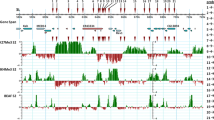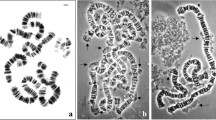Abstract
Antigens ofChironomus reactive with human sera containing anti-Ku antibodies and also with specific antibodies to each Ku subunit were characterized by immunoblot analysis. Three main antigen species were identified in nuclear-enriched extracts from salivary gland cells ofChironomus thummi, ranging in Mr from 55000 to 67000. The nuclear localization of Ku-related antigens in the dipteranChironomus was studied by immunofluorescent labeling in polytene chromosomes of the salivary glands. Balbiani rings, loci highly active in transcription, were found to be strongly labeled by anti-Ku antibodies. Sugar-induced changes in the activity of the Balbiani ring genes were accompanied by the redistribution of Ku-related antigens as visualized by their absence in regressed Balbiani ring loci, and continued presence only in those that were transcriptionally active. A drastic change in the distribution of Ku-related antigens was also observed whenC. thummi larvae underwent heat treatment as the immunofluorescent staining was restricted to previously described heat shock puffs. Anti-Ku sera reacted in addition with several chromosomal bands in which the presence of RNA polymerase II was also immunologically detected. The results show thatChironomus antigens reactive with anti-Ku antibodies are related to transcription in polytene chromosomes.
Similar content being viewed by others
References
Amabis JM, Amabis DC, Kaburaki J, Stollar BD (1990) The presence of an antigen reactive with a human autoantibody inTrichosia pubescens (Diptera: Sciaridae) and its association with certain transcriptionally active regions of the genome. Chromosoma 99:102–110
Barettino D, Morcillo G, Díez JL, Carretero MT, Carmona MJ (1988) Correlation between the activity of a 5,6-dichloro-1-β-d-ribofuranosylbenzimidazole-insensitive puff and the synthesis of major heat-shock polypeptide, hsp70, inChironomus thummi. Biochem Cell Biol 66:1177–1185
Beall EL, Rio DC (1996)Drosophila IRBP/Ku p70 corresponds to mutagen-sensitive mus309 gene and is involved in P-element excision in vivo. Genes Dev 10:921–933
Beall EL, Admon A, Rio DC (1994) ADrosophila protein homologous to the human p70 Ku autoimmune antigen interacts with the P transposable elements inverted repeats. Proc Natl Acad Sci USA 91:12681–12685
Beermann W (1961) Ein Balbiani Ring als Locus einer Speicheldrüsenmutation. Chromosoma 12:1–25
Beermann W (1973) Directed changes in the pattern of Balbiani ring puffing inChironomus: effects of a sugar treatment. Chromosoma 41:297–326
Dalziel RG, Mendelson SC, Quinn JP (1992) The nuclear autoimmune antigen Ku is also present on the cell surface. Autoimmunity 13:265–267
Díaz V, Quintanilla M, Cruces J, Renart J, Sebastian J (1987) Immunological relationships betweenArtemia RNA polymerases and between RNA polymerases II from different eukaryotic organisms. Mol Cell Biochem 76:123–131
Díez JL, Barettino D (1984) DNA-RNA hybrids and transcriptional activity inChironomus polytene chromosomes. Chromosoma 90:103–110
Díez JL, Cortés E, Merino Y, Santa-Cruz MC (1990) Galactose-induced changes inChironomus thummi Balbiani rings and their dependence on protein synthesis. Chromosoma 99:61–70
Dvir A, Peterson SR, Knuth MW, Lu H, Dynan WS (1992) Ku autoantigen is the regulatory component of a template-associated protein kinase that phosphorylates RNA polymerase II. Proc Natl Acad Sci USA 89:11920–11924
Dvir A, Stein LY, Calore BL, Dynan WS (1993) Purification and characterization of a template-associated protein kinase that phosphorylates RNA polymerase II. J Biol Chem 268:10440–10447
Edström JE, Rydlander L, Francke C (1980) Concomitant induction of a Balbiani ring and a giant secretory protein inChironomus salivary glands. Chromosoma 81:115–124
Egyházi E, Ossoinak A, Pigon A, Holmgren C, Lee JM, Greenleaf AL (1996) Phosphorylation dependence of the initiation of productive transcription of Balbiani ring 2 genes in living cells. Chromosoma 104:422–433
Falzon M, Kuff EL (1992) The nucleotide sequence of a mouse cDNA encoding the 80 KDa subunit of the Ku (p70/p80) autoantigen. Nucleic Acids Res 20:3784
Falzon M, Fewell JW, Kuff EL (1993) EBP-80, a transcription factor closely resembling the human autoantigen Ku, recognizes single to double-strand transitions in DNA. J Biol Chem 268:10546–10552
Feldmann H, Winnacker EL (1993) A putative homologue of the human autoantigen Ku fromSaccharomyces cerevisiae. J Biol Chem 268:12895–12900
Genersch E, Eckerskorn C, Lottspeich F, Herzog KK, Pöschl E (1995) Purification of the sequence-specific transcription factor CTCBF, involved in the control of human collagen IV genes; subunits with homology to Ku antigen. EMBO J 14:791–800
Getts RC, Stamato TD (1994) Absence of Ku-like DNA binding activity in the xrs double-strand DNA repair deficient mutant. J Biol Chem 269:15981–15984
Giffin W, Torrance H, Rodda DJ, Préfontaine GG, Pope L, Haché RJG (1996) Sequence-specific DNA binding by Ku autoantigen and its effects on transcription. Nature 380:265–268
Gottlieb TM, Jackson SP (1993) The DNA-dependent protein kinase: requirement for DNA ends and its association with Ku antigen. Cell 72:131–142
Griffith AJ, Blier PR, Mimori T, Hardin JA (1992a) Ku polypeptides synthesized in vitro assemble into complexes which recognize ends of double-stranded DNA. J Biol Chem 267:331–338
Griffith AJ, Craft J, Evans J, Mimori T, Hardin JA (1992b) Nucleotide sequence and genomic structure analysis of the p70 subunit of the human Ku autoantigen: evidence for a family of genes encoding Ku (p70)-related polypeptides. Mol Biol Rep 16:91–97
Grond C, Saiga H, Edström JE (1987) The sp-1 genes in the Balbiani rings ofChrinomus salivary glands. In: Hennig W (ed) Results and problems in cell differentiation, vol. 14. Springer-Verlag, Berlin Heidelberg New York London Paris Tokyo, pp 69–80
Hoff CM, Jacob ST (1993) Characterization of the factor E1BF from a rat hepatoma that modulates ribosomal RNA gene transcription and its relationship to the human Ku autoantigen. Biochem Biophys Res Commun 190:747–753
Hoff CM, Ghosh AK, Prabhakar BS, Jacob ST (1994) Enhancer 1 binding factor, a Ku-related protein, is a positive regulator of RNA polymerase I transcription initiation. Proc Natl Acad Sci USA 91:762–766
Jacoby DB, Wensink PC (1994) Yolk protein factor 1 is aDrosophila homolog of Ku, the DNA-binding subunit of the DNA-dependent protein kinase from humans. J Biol Chem 269:11484–11491
Kaczmarski W, Khan SA (1993) Lupus autoantigen Ku protein binds HIV-1 TAR RNA in vitro. Biochem Biophys Res Commun 196:935–942
Kim D, Ouyang H, Yang SH, Nussenzweig A, Burgman P, Li GC (1995) The constitutive heat shock element-binding factor is immunologically identical to the Ku autoantigen. J Biol Chem 270:15277–15284
Khun A, Stefanovsky V, Grummt I (1993) The nucleolar transcription activator UBF relieves Ku antigen-mediated repression of mouse ribosomal gene transcription. Nucleic Acids Res 21:2057–2063
Knuth MW, Gunderson SI, Thompson NE, Strasheim LA, Burgess RR (1990) Purification and characterization of PSE1, a transcription activating protein related to Ku and TREF that binds the proximal sequence element of the Human U1 promoter. J Biol Chem 265:17911–17920
Lehmann AR (1995) Nucleotide excision repair and the link with transcription. Trends Biochem Sci 20:402–405
Li GC, Yang SH, Kim D, Nussenzweig A, Ouyang H, Wie J, Burgman P, Li L (1995) Supression of heat-induced hsp70 expression by the 70-kDa subunit of the human Ku autoantigen. Proc Natl Acad Sci USA 92:4512–4516
May G, Sutton C, Gould H (1991) Purification and characterization of Ku-2, an octamer-binding protein related to the autoantigen Ku. J Biol Chem 266:3052–3059
Messier H, Fuller T, Mangal S, Brickner H, Igarashi S, Gaikwad J, Fotedar R, Fotedar A (1993) p70 lupus autoantigen binds to the enhancer of the T-cell receptor beta-chain gene. Proc Natl Acad Sci USA 90:2685–2689
Mimori T, Akizuki M, Yamagata H, Inada S, Yoshida S, Homma M (1981) Characterization of a high molecular weight acidic nuclear protein recognized by autoantibodies in sera from patients with polymyositis-scleroderma overlap. J Clin Invest 68:611–620
Mimori T, Hardin JA, Steitz JA (1985) Characterization of the DNA-binding protein antigen Ku recognized by autoantibodies from patients with rheumatic disorders. J Biol Chem 2274–2278
Morcillo G, Santa Cruz MC, Díez JL (1981) Temperature-induced Balbiani ring inChironomus thummi. Chromosoma 83:341–352
Morcillo G, Díez JL, Carbajal ME, Tanguay RM (1993) HSP90 associates with specific heat shock puffs (hsrω) in polytene chromosomes ofDrosophila andChironomus. Chromosoma 102:648–659
Morcillo G, Díez JL, Botella LM (1994) Heat shock activation of telomeric sequences in different tissues ofChironomus thummi. Exp Cell Res 211:263–267
Morozov VE, Falzon M, Anderson CW, Kuff EL (1994) DNA-dependent protein kinase is activated by nicks and larger single-stranded gaps. J Biol Chem 269:16684–16688
Nelson LG, Daneholt B (1981) Modulation of 75S RNA synthesis in the Balbiani rings ofChironomus tentans with galactose treatment. Chromosoma 83:645–659
Niu H, Zhang J, Jacob ST (1995) E1BF/Ku interacts physically and functionally with the core promoter binding factor CPBF and promotes the basal transcription of rat and human ribosomal RNA genes. Gene Expr 4:111–124
Pelling C (1964) Ribonucleinsäuresynthese der Riesenchromosomen. Autoradiographische Untersuchungen anchironomus tentans. Chromosoma 15:71–122
Reeves WH, Sthoeger ZM (1989) Molecular cloning of cDNA encoding the p70(Ku) lupus autoantigen. J Biol Chem 264:5047–5052
Santa-Cruz MC, Villanueva A, Díez JL (1978) Effect of galactose treatment in the puffing pattern ofChironomus thummi Balbiani rings. Chromosoma 69:93–100
Santa-Cruz MC, Morcillo M, Díez JL (1984) Ultrastructure of a temperature-induced Balbiani Ring inChironomus thummi. Biol Cell 52:205–212
Sass H (1980) Features of in vitro puffing and RNA synthesis in polytene chromosomes ofChironomus. Chromosoma 78:33–78
Sass H (1982) RNA polymerase B in polytene chromosomes: immunofluorescent and autoradiographic analysis during stimulated and repressed RNA synthesis. Cell 28:269–278
Schreibert E, Matthis P, Müller MM, Schaffner W (1988) Identification of a novel lymphoid specific octamer binding protein (OTF-2B) by proteolytic clipping bandshift assay (PCBA). EMBO J 7:4221–4229
Tan EM (1991) Autoantibodies in pathology and cell biology. Cell 67:841–842
Troelstra C, Jaspers NGJ (1994) Ku starts at the end. Curr Biol 12:1149–1151
Tuteja N, Tuteja R, Ochem A, Taneja P, Huang NW, Simonscits A, Susic S, Rahman K, Marusic L, Chen J, Zhang J, Wang S, Pongor S, Falaschi A (1994) Human DNA helicase II: a novel DNA unwinding enzyme identified as the Ku autoantigen. EMBO J 13:4991–5001
Wang J, Satoh M, Pierani A, Schmitt J, Chou C-H, Stunnemberg HG, Roeder RG, Reeves WH (1994) Assembly and DNA binding of recombinant Ku(p70/p80) autoantigen defined by a novel monoclonal antibody specific for p70/p80 heterodimers. J Cell Sci 107:3223–3233
Weaver DT (1995) V(D)J recombination and double-strand break repair. Adv Immunol 58:29–85
Yaneva M, Wen J, Ayala A, Cook R (1989) cDNA-derived amino acid sequence of the 86-kDa subunit of the Ku antigen. J Biol Chem 264:13407–13411
Author information
Authors and Affiliations
Additional information
Edited by: W. Hennig
Rights and permissions
About this article
Cite this article
Gorab, E., Botella, L.M., Quinn, J.P. et al. Ku-related antigens are associated with transcriptionally active loci inChironomus polytene chromosomes. Chromosoma 105, 150–157 (1996). https://doi.org/10.1007/BF02509496
Received:
Revised:
Accepted:
Issue Date:
DOI: https://doi.org/10.1007/BF02509496




